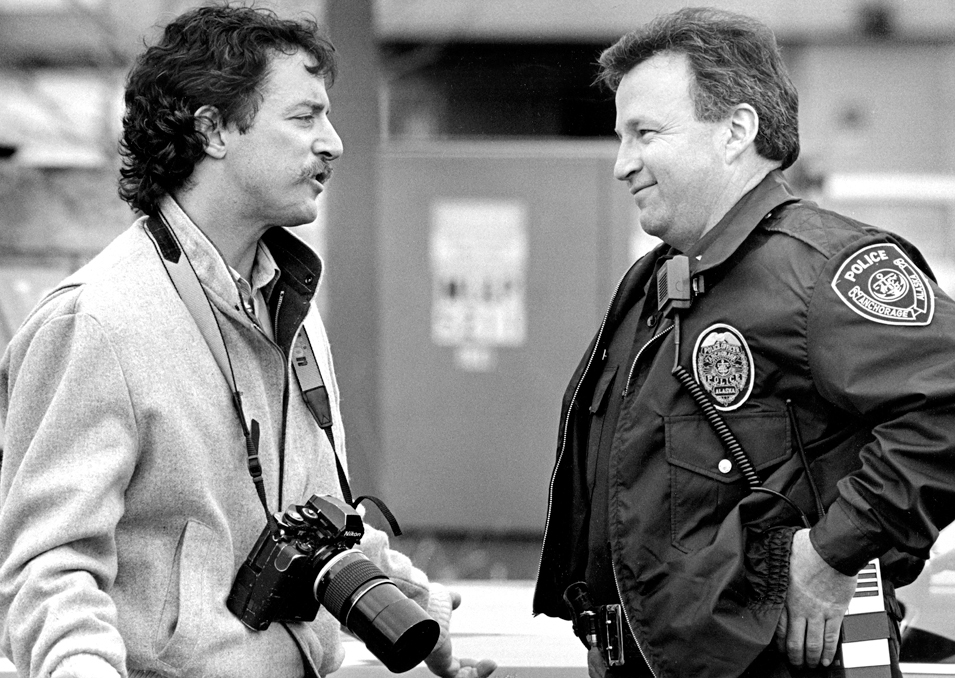In the introduction to his book, “Snap Decisions,” photojournalist Jim Lavrakas calls himself “the last ambulance chaser.” A big hunk of the 152-page photo-filled memoir includes pictures of what a 20th century daily newspaper photographer did — shooting fires, car wrecks, crime scenes and even a fiery bomb blast.
Lavrakas, now a Homer fishing guide, might just as well call himself a veteran of the last newspaper war. He had the luck to work for the Anchorage Daily News during its epic battle against the Anchorage Times. In today’s modern journalism world, newspapers fade from publishing daily to publishing online, or even not at all. From 1979 after the McClatchy Newspaper chain bought the struggling paper until 1992 when the Times folded, Lavrakas shot on the front lines, trying to scoop his competitors and the photos they missed — “head to head with Goliath,” he said.
At 6 p.m. today at the Kachemak Bay Campus, Lavrakas holds the Alaska premiere of his book, published through his company, Far North Press, and partially funded by generous patrons through Kickstarter, the online project fundraising program. Lavrakas shows a video presentation of his book, and will discuss his 30-year career in photojournalism. The Homer Bookstore sells copies of “Snap Decisions,” and he’ll be available afterward for a signing. On Tuesday, he has the Anchorage launch party in the lobby of the Anchorage Daily News, followed by book signings on Wednesday at Fireside Books in Palmer and on Nov. 24 at the Loussac Library, Anchorage.
As a budding photographer, Lavrakas said he’d wanted to be a National Geographic photographer, traveling to distant lands and taking pictures of exotic and wild places. Years later, he realized he’d been doing exactly that. Charter a pilot and Cessna 206 to cover the Iditarod Sled Dog Race? Fly to Barrow for a bowhead whale hunt? McClatchy had the budget.
“It was a photographer’s dream,” Lavrakas said. “You have a free ride to the greatest state in the union.”
Born in Lowell, Mass, and raised in Dunstable, Lavrakas credits his father, Babe Lavrakas, with inspiring him in photography. Babe taught chemistry at Lowell Technological Institute. One day his dad was working in a darkroom and told Jim he should come down and see some applied chemistry. They put a print in developing chemicals.
“I said, ‘My God, this isn’t chemistry. This is magic,’” Lavrakas said.
As a teenager, he paid for his hobby by selling bucolic country photos to the Lowell Sun newspaper. At the University of Massachusetts, Amherst, he worked on the student newspaper. Through a college friend, Jim Nardelli, Lavrakas first came up to Homer in 1973, after his junior year. He moved to Alaska after graduating in 1974, working in Girdwood at Alyeska Ski Resort and then as a gandy dancer with the Alaska Railroad.
Lavrakas started his Alaska photo career shooting opera, theater and music performances in Anchorage. After filling in for the legendary photographer Alice Puster at the Anchorage Times in 1979, he talked himself into a job at the Daily News. That turned out to be a glory period in Alaska journalism, with the oil pipeline just coming online and Anchorage transforming from a rustic town into a modern, cosmopolitan city.
“I can’t think of a better time,” Lavrakas said. “There was still this rough-hewn, rough edged society.”
That career resulted in some iconic photos, like a police bomb disposal officer on fire when a bomb blew or the photographer’s dream, an original image — a photo never before taken — of a rainbow trout eaten by a northern pike and inside its mouth. “Snap Decisions” includes Lavrakas’ 20 favorite photos.
Some of them deeply affected Lavrakas, like an image of B.J. Lewis, a dying Korean War combat veteran who fought at the Chosin Reservoir, being honored for his service by fellow Marines. The image shows two Marines in dress uniform reverently handling mementoes of Lewis’ service.
“I hid behind the camera because it was so emotional,” Lavrakas said.
Getting Kickstarter funding helped Lavrakas create an elegant, finely produced book that’s as much an art collection as it is a memoir. Kickstarter patrons put up all but $6,000 of the book’s $18,000 cost, including production and printing of 2,000 copies. The big donors are acknowledged in the book, and every patron gets a copy.
Much of the work Lavrakas did himself, but he hired a designer to tie together all the elements of “Snap Decisions” and a photo house to process images. Through a deal with Ken Sturgis, Aftershocks Media is doing wholesale distribution in Alaska.
Aside from chasing down photographs, Lavrakas said he cultivated another skill that allowed him to be there at the right place and the right time: getting to know the cops, medics and firefighters.
“It came down to understanding that the public servants who do their work for you — they have a hard job,” he said. “Showing that to readers was what I really came to value and strive to do.”
He also got to know the hundreds of characters who make Alaska such a fascinating place to work.
“In Anchorage, by the end of my career I couldn’t walk down Fourth Avenue without saying hello to a couple of people,” Lavrakas said. “It might be Tony Knowles or it might be Ziggy the shoeshine guy.”
For photojournalists and journalists trying to make a career, Lavrakas had some advice.
“Hyperlocal journalism is the only kind of savior for a city’s newspaper,” he said. “You focus on what’s happening in your community and the issues that are affecting it at any time and the personalities in your community.”
Michael Armstrong can be reached at michael.armstrong@homernews.com.


